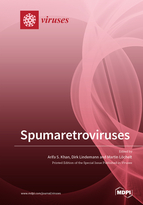Spumaretroviruses
A special issue of Viruses (ISSN 1999-4915). This special issue belongs to the section "Animal Viruses".
Deadline for manuscript submissions: closed (31 August 2019) | Viewed by 67840
Special Issue Editors
Interests: retrovirus biology and genomics; in vitro models for virus-host interactions; SIV monkey models; viral vaccines; high-throughput sequencing; bioinformatics; novel virus discovery
Special Issues, Collections and Topics in MDPI journals
Interests: virus—host interactions; molecular and cellular biology of retroviruses; development and application of retroviral vector systems
Special Issues, Collections and Topics in MDPI journals
Interests: virus—host interactions; molecular and cellular biology of retroviruses in vitro and in vivo; foamy virus vector systems for gene delivery and antigen presentation; infection, inflammation, and cancer
Special Issue Information
Dear Colleagues,
Foamy Viruses (FVs) of the sub-family Spumaretrovirnae are unconventional retroviruses with several unique features in their replication that distinguish them from Orthoretrovirinae. Evolutionary studies revealed that FVs are the most ancient retroviruses, with endogenous elements present in species ranging from fish to mammals. Exogenous FVs circulate and co-speciate with their mammalian hosts such as non-human primates, bovines, equines, and felines, and inter-species infections can occur. Furthermore, cross-species infections may occur in humans through exposure to infected non-human primates. FV infections are considered apathogenic upon natural, experimental, or zoonotic transmission. This co-existence of FVs with their hosts and the potential of FVs as co-pathogens are topics of intense investigations, as well as the interactions of FVs with innate immunity and immune recognition and evasion.
FV molecular biology is unique and provides exciting insights into the breadth of retrovirus replication strategies. Additionally, FVs are an excellent model organism for retroviruses in general; in fact, the first atomic structure of the intasome complex containing full-length retroviral integrase was from a prototype FV and serves as a blueprint for corresponding investigations in other retroelements. Due to their apparent lack of pathogenicity and other features such as their broad tropism, FVs are engineered as novel vectors for gene therapy, vaccine antigen expression, and targeted protein and RNA transfer.
This Special Issue aims to provide new insights and a comprehensive overview of all aspects of FV biology including molecular and cellular biology, virus-host interactions, molecular evolution, epidemiology, structural biology, gene therapy vectors, and translational research. We cordially invite you to contribute original papers and review articles on these and related topics to highlight recent advances in spumaretrovirus research.
Dr. Arifa S. Khan
Prof. Dr. Dirk Lindemann
Prof. Dr. Martin Löchelt
Guest Editors
Manuscript Submission Information
Manuscripts should be submitted online at www.mdpi.com by registering and logging in to this website. Once you are registered, click here to go to the submission form. Manuscripts can be submitted until the deadline. All submissions that pass pre-check are peer-reviewed. Accepted papers will be published continuously in the journal (as soon as accepted) and will be listed together on the special issue website. Research articles, review articles as well as short communications are invited. For planned papers, a title and short abstract (about 100 words) can be sent to the Editorial Office for announcement on this website.
Submitted manuscripts should not have been published previously, nor be under consideration for publication elsewhere (except conference proceedings papers). All manuscripts are thoroughly refereed through a single-blind peer-review process. A guide for authors and other relevant information for submission of manuscripts is available on the Instructions for Authors page. Viruses is an international peer-reviewed open access monthly journal published by MDPI.
Please visit the Instructions for Authors page before submitting a manuscript. The Article Processing Charge (APC) for publication in this open access journal is 2600 CHF (Swiss Francs). Submitted papers should be well formatted and use good English. Authors may use MDPI's English editing service prior to publication or during author revisions.
Keywords
- spumaretroviruses
- foamy viruses
- complex retroviruses
- ancient retroviruses
- natural infections
- zoonoses
- foamy virus prevalence
- nonhuman primates and non primates
- foamy virus-host interactions
- molecular biology and replication
- viral proteins
- restriction factors
- virus detection assays
- antivirals
- foamy virus vectors







